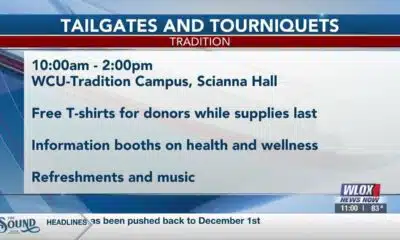News from the South - North Carolina News Feed
What was the economic impact of the Billy Strings concerts? When will submerged vehicles be pulled from the rivers? • Asheville Watchdog
Today’s round of questions, my smart-aleck replies, and the real answers:
Question: Billy Strings, the bluegrass musician, just finished two weekends of sold-out concerts here in Asheville at our old but comfortable Harrah’s Cherokee Center-Asheville (the Civic Center to us oldies). Downtown felt like the special weird Asheville that has been missing for a while. Can you use your “sources” to find out what the economic impact of these past two weeks of events were? Seems to me that it was pretty beneficial.
My answer: Coincidentally, “old but comfortable” is how my wife describes me to friends.
Real answer: Strings and his band played sold-out shows from Feb. 6-8, and Feb. 14-16.
Chris Corl, general manager of the Harrah’s Cherokee Center-Asheville, said staff does feel events they put together do help to drive business in the community, “specifically hitting one of our annual targets of driving business during more of the ‘offseason.’”
“This year’s six-show run with Billy Strings in the ExploreAsheville.com Arena was part of a major push at the start of February,” Corl said. “Between Feb. 2 and 16, we hosted twelve events with a total attendance of 46,581. The six shows with Billy Strings were responsible for the majority, with an attendance totaling 38,174.”
Corl checked ticket sales data, finding that concert-goers came from all 50 states, Puerto Rico, and five countries – 121 tickets were sold to fans from Great Britain.
“Fun fact: I bumped into an old friend from my time in high school who flew in with her family from Portland, Oregon, just to catch the second weekend of shows,” Corl said.
Corl also noted that Strings and his team did a “locals-only” pre-sale.
“These shows were supposed to go on sale to the public on Oct. 11, but this was delayed due to Hurricane Helene,” Corl said. “When we did go on sale at the beginning of November, Billy’s team allowed us to utilize a geo-focused ticket pre-sale here at the box office and online with Zip code tracking, allowing only individuals in the FEMA-recognized affected counties early access to tickets.”
Those counties included those in western North Carolina, upstate South Carolina and Eastern Tennessee.
Corl consulted with Explore Asheville (the convention and visitors bureau) and the Buncombe County Tourism Development Authority on the economic impact.
Corl said “direct spending generated in the Asheville area by the Billy Strings concerts is estimated at $15.7 million, including $6.3 million in lodging revenue and $3.5 million in food and beverage sales. Other categories comprising the remainder include transportation, retail sales, recreation, space rental and business services.”
“From the venue side, a quick tally shows that we paid local nonprofit groups $61,519 for their assistance in our bars and concession stands,” Corl said. “Our in-house food and beverage staff received $44,720 in tips from the attendees, and we paid out $250,117 in direct wages for staff working the event. The latter value does not include our salaried full-time staff helping to execute the event.”
Corl said the center is already working with Strings’s team on a return run for next year, “with hopes of finding a way to further create a significant impact in Asheville and Buncombe County.”
Corl also offered a reminder that the Ingles Southern Conference Men’s and Women’s Basketball Championships will be held March 6-10 at Harrah’s Cherokee Center-Asheville.


Question: Driving along Thompson Street along the Swannanoa River bank from Biltmore Avenue to where Brother Wolf is, there are still, after five months, submerged vans, cars and trucks in the river. It looks like a graveyard. What is going on? Are there still corpses in those vehicles?
My answer: I’m no expert on search, rescue, and recovery, but I’m pretty sure they check these vehicles real soon after a disaster.
Real answer: The vehicles were indeed searched soon after Tropical Storm Helene hit on Sept. 27.
“In September 2024 and October 2024, search and rescue teams searched and documented 987 vehicles and vessels impacted by the storm within city limits,” city of Asheville spokesperson Kim Miller told me via email. “This included titled property such as vehicles, boats, campers, and trailers.”

Miller said non-titled property, such as shipping containers, will be taken to Enka Commerce Park for processing.
“City staff reevaluated the number of impacted vehicles still located in rights-of-way or waterways, and the number was reduced to 80 located in the waterway,” Miller said. “Contractors will retrieve and document the remaining vehicles and vessels. These vehicles will be transported to contracted towing facilities or a central holding location, and a formal notification process will be carried out in compliance with legal requirements.”
The city and Buncombe County are working on vehicle removals with FEMA, the U.S. Army Corps of Engineers, the state, and debris removal contractors.
Since the waterway operation began Feb. 1, Miller said, the Army Corps of Engineers and the debris removal contractor have continued to ramp up crews.
“They are currently focused on the Swannanoa River in east Asheville and sections of the French Broad River,” Miller said. “As they complete sections, they will move to other waterway sections.”
As we reported earlier this month, the Army Corps said all Buncombe County river debris cleanups should be finished by June 1, private property debris removal by June 30, and right-of-way debris removal by April 1. The Army Corps said then it had 10 crews working and expected to add another 20 to 25 this month.
“Finding staging areas and safe access points for the heavy equipment needed for this task impacts the speed of the operations,” Miller said. “So does the weather, as rain creates unsuitable conditions in our already compromised waterways.”

Update on the Western North Carolina Nature Center: In a January Answer Man column, I noted that the WNC Nature Center — and most importantly, its animals — survived Helene without major damage or injuries.

The Nature Center announced Monday that it will reopen to the public March 17,
five and a half months after closing because Helene caused significant flooding that destroyed roads and the main bridge to the Nature Center.
The Nature Center will open a week earlier for Friends of the WNC Nature Center members from March 10 to March 16. You can buy or renew memberships online at www.wildwnc.org/membership or at the membership office and still be able to take advantage of members-only week.
No admission tickets will be sold during this members-only week.
“After witnessing the devastation caused by the flooding of the Swannanoa River, we
thought it would be at least a year until we could safely reopen,” Nature Center
Director Chris Gentile said in a news release. “Thanks to the steadfast work of our city workers, the NCDOT and a myriad of community partners, we are ready to welcome guests.”
Because of the loss of the Gashes Creek Bridge, you’ll have to take a different route to the center, though.
Drive to the Nature Center as normal, turning from Swannanoa River Road onto
Azalea Road, but instead of turning right to cross the bridge, continue straight for half a mile. This road is now two-way all the way to the roundabout. At the roundabout, take the first right. A traffic signal has been installed on either side of the one-way metal bridge. After crossing the metal bridge, turn left on Gashes Creek Road and enter the Nature Center’s parking lots.
Asheville Watchdog is a nonprofit news team producing stories that matter to Asheville and Buncombe County. Got a question? Send it to John Boyle at jboyle@avlwatchdog.org or 828-337-0941. His Answer Man columns appear each Tuesday and Friday. The Watchdog’s reporting is made possible by donations from the community. To show your support for this vital public service go to avlwatchdog.org/support-our-publication/.
Related
The post What was the economic impact of the Billy Strings concerts? When will submerged vehicles be pulled from the rivers? • Asheville Watchdog appeared first on avlwatchdog.org
News from the South - North Carolina News Feed
White House officials hold prayer vigil for Charlie Kirk
SUMMARY: Republican lawmakers, conservative leaders, and Trump administration officials held a prayer vigil and memorial at the Kennedy Center honoring slain activist Charlie Kirk, founder of Turning Point USA. Kirk was killed in Utah, where memorials continue at Utah Valley University and Turning Point USA’s headquarters. Police say 22-year-old Tyler Robinson turned himself in but has not confessed or cooperated. Robinson’s roommate, his boyfriend who is transitioning, is cooperating with authorities. Investigators are examining messages Robinson allegedly sent on Discord joking about the shooting. Robinson faces charges including aggravated murder, obstruction of justice, and felony firearm discharge.
White House officials and Republican lawmakers gathered at the Kennedy Center at 6 p.m. to hold a prayer vigil in remembrance of conservative activist Charlie Kirk.
https://abc11.com/us-world/
Download: https://abc11.com/apps/
Like us on Facebook: https://www.facebook.com/ABC11/
Instagram: https://www.instagram.com/abc11_wtvd/
Threads: https://www.threads.net/@abc11_wtvd
TIKTOK: https://www.tiktok.com/@abc11_eyewitnessnews
News from the South - North Carolina News Feed
Family, friends hold candlelight vigil in honor of Giovanni Pelletier
SUMMARY: Family and friends held a candlelight vigil in Apex to honor Giovanni Pelletier, a Fuquay Varina High School graduate whose body was found last month in a Florida retention pond. Giovanni went missing while visiting family, after reportedly acting erratically and leaving his cousins’ car. Loved ones remembered his infectious smile, laughter, and loyal friendship, expressing how deeply he impacted their lives. His mother shared the family’s ongoing grief and search for answers as authorities continue investigating his death. Despite the sadness, the community’s support has provided comfort. A celebration of life mass is planned in Apex to further commemorate Giovanni’s memory.
“It’s good to know how loved someone is in their community.”
More: https://abc11.com/post/giovanni-pelletier-family-friends-hold-candlelight-vigil-honor-wake-teen-found-dead-florida/17811995/
Download: https://abc11.com/apps/
Like us on Facebook: https://www.facebook.com/ABC11/
Instagram: https://www.instagram.com/abc11_wtvd/
Threads: https://www.threads.net/@abc11_wtvd
TIKTOK: https://www.tiktok.com/@abc11_eyewitnessnews
News from the South - North Carolina News Feed
NC Courage wins 2-1 against Angel City FC
SUMMARY: The North Carolina Courage defeated Angel City FC 2-1 in Cary, ending their unbeaten streak. Monaca scored early at the 6th minute, followed by Bull City native Brianna Pinto’s goal at the 18th minute, securing a 2-0 halftime lead. Angel City intensified in the second half, scoring in the 88th minute, but the Courage held firm defensively to claim victory. Pinto expressed pride in the win, emphasizing the team’s unity and playoff ambitions. Nearly 8,000 fans attended. Coverage continues tonight at 11, alongside college football updates, including the Tar Heels vs. Richmond game live from Chapel Hill.
Saturday’s win was crucial for the Courage as the regular season starts to wind down.
https://abc11.com/post/north-carolina-courage-wins-2-1-angel-city-fc/17810234/
Download: https://abc11.com/apps/
Like us on Facebook: https://www.facebook.com/ABC11/
Instagram: https://www.instagram.com/abc11_wtvd/
Threads: https://www.threads.net/@abc11_wtvd
TIKTOK: https://www.tiktok.com/@abc11_eyewitnessnews
-
News from the South - Kentucky News Feed6 days ago
Lexington man accused of carjacking, firing gun during police chase faces federal firearm charge
-
The Center Square7 days ago
California mother says daughter killed herself after being transitioned by school | California
-
News from the South - Alabama News Feed6 days ago
Zaxby's Player of the Week: Dylan Jackson, Vigor WR
-
News from the South - Arkansas News Feed6 days ago
Arkansas medical marijuana sales on pace for record year
-
Local News Video7 days ago
William Carey University holds 'tailgates and tourniquets' blood drive
-
News from the South - North Carolina News Feed5 days ago
What we know about Charlie Kirk shooting suspect, how he was caught
-
News from the South - Missouri News Feed6 days ago
Local, statewide officials react to Charlie Kirk death after shooting in Utah
-
Local News6 days ago
US stocks inch to more records as inflation slows and Oracle soars















































